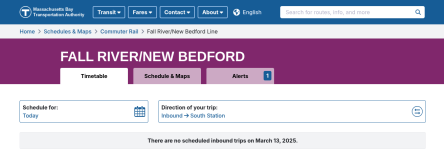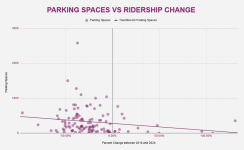Roughly eyeballing the write-up, it looks like ridership recovery is worst at stations that were most reliant on park and ride pre-COVID. This seems about right, with hybrid work making monthly CR passes less attractive, especially if you already own a car. Looking at
appendices 1 & 2 from a 2018
MPO park and ride study, ridership at CR stations that had the most cars parked seems to have suffered particularly poorly. Some examples:
- Anderson/Woburn (841 parked cars, 48% ridership decline)
- Lowell (597 parked cars, 36% ridership decline)
- North Billerca (520 parked cars, 35% ridership decline)
- Norfolk (506 parked cars, 51% decline)
- Route 128 (1800 parked cars, 41% decline)
It would be interesting to do a full regression analysis, but the Open Data Portal hasn't actually been updated with Fall 2024 data.
Also, it is really impressive seeing the virtuous cycle between ridership and development take place at Boston Landing. It's a pretty clear testament to the success of TOD, and should only continue growing as other nearby projects get completed. Here's hoping that we can see similarly dense development near other Commuter Rail stops sooner rather than later.




